Trigonal pyramidal Study guides, Class notes & Summaries
Looking for the best study guides, study notes and summaries about Trigonal pyramidal? On this page you'll find 193 study documents about Trigonal pyramidal.
Page 4 out of 193 results
Sort by
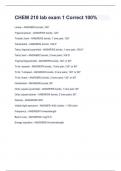
-
CHEM 210 lab exam 1 Correct 100%
- Exam (elaborations) • 1 pages • 2024
- Available in package deal
-
- $10.99
- + learn more
Linear - ANSWER2 bonds, 180° Trigonal planar - ANSWER3 bonds, 120° Tri-plan; bent - ANSWER2 bonds, 1 lone pair, 120° Tetrahedral - ANSWER4 bonds; 109.5° Tetra; trigonal pyramidal - ANSWER3 bonds, 1 lone pair; 109.5° Tetra; bent - ANSWER2 bonds, 2 lone pairs; 109.5° Trigonal bipyramidal - ANSWER5 bonds; 120° or 90° Tri bi; seesaw - ANSWER4 bonds, 1 lone pair; 120
![[AP Chemistry] VSEPR Summary Questions And Answers Rated A+](/docpics/5544097/666041759ecdb_5544097_121_171.jpeg)
-
[AP Chemistry] VSEPR Summary Questions And Answers Rated A+
- Exam (elaborations) • 2 pages • 2024
- Available in package deal
-
- $7.99
- + learn more
2 Bonds and 0 Lone Pairs - Bond Angle: 180 Geometry of Electron Pairs: Linear Geometry of Atoms: Linear 3 Bonds and 0 Lone Pairs - Bond Angle: 120 Geometry of Electron Pairs: Trigonal Planar Geometry of Atoms: Trigonal Planar 2 Bonds and 1 Lone Pair - Bond Angle: Slightly less than 120 Geometry of Electron Pairs: Trigonal Planar Geometry of Atoms: Bent or V Shaped 4 Bonds and 0 Lone Pairs - Bond Angle: 109.5 Geometry of Electron Pairs: Tetrahedral Geometry of Atoms: Tetrahedral 3 Bon...
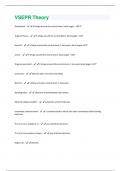
-
VSEPR Theory Questions and Answers with complete solution
- Exam (elaborations) • 2 pages • 2024
- Available in package deal
-
- $7.99
- + learn more
Tetrahedral - 4 things around the central atom, bond angle = 109.5° Trigonal Planar - 3 things around the central Atom, bond angle = 120° bent #2 - 4 things around the central atom, 2 lone pairs, bond angle <105° Linear - 2 things around the central atom, bond angle = 180° Trigonal pyramidal - 4 things around the central atom, 1 lone pair, bond angle <107° Lone pairs - Electron pairs not used in bonding Bent #1 - 3 things around a central atom, 1 lone pairs Bonding pairs - elec...
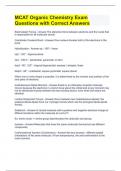
-
MCAT Organic Chemistry Exam Questions with Correct Answers
- Exam (elaborations) • 20 pages • 2024
- Available in package deal
-
- $16.49
- + learn more
Electrostatic Forces - Answer-The attractive force between electrons and the nuclei that is responsible for all molecular bonds. Coordinate Covalent Bond - Answer-One nucleus donates both of the electrons in the bond. Hybridization - Answer-sp - 180° - linear sp2 - 120° - trigonal planar sp3 - 109.5° - tetrahedral, pyramidal, or bent dsp3 - 90°, 120° - trigonal-bipyramidal, seesaw, t-shaped, linear d2sp3 - 90° - octahedral, square pyramidal, square planar When one or m...
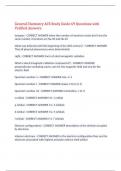
-
General Chemistry ACS Study Guide 69 Questions with Verified Answers,100% CORRECT
- Exam (elaborations) • 5 pages • 2024
-
- $11.19
- + learn more
General Chemistry ACS Study Guide 69 Questions with Verified Answers Isotopes - CORRECT ANSWER when the number of neutrons varies but it has the same number of protons ex) Ne-20 and Ne-22` What was believed until the beginning of the 20th century? - CORRECT ANSWER That all physical phenomena were deterministic Light - CORRECT ANSWER Form of electromagnetic radiation What is electromagnetic radiation composed of? - CORRECT ANSWER perpendicular oscillating waves, one for the magnetic f...
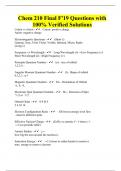
-
Chem 210 Final F'19 Questions with 100% Verified Solutions
- Exam (elaborations) • 7 pages • 2023
- Available in package deal
-
- $10.99
- + learn more
Cation vs Anion - Cation- positive charge Anion- negative charge Electromagnetic Spectrum - (Short λ) Gamma, Xray, Ultra Violet, Visible, Infrared, Micro, Radio (Long λ) Frequency vs Wavelength - Long Wavelength (λ)→Low Frequency (v) Short Wavelength (λ)→High Frequency (v) Principle Quantum Number - (n) - size of orbital 1,2,3,4... Angular Moment Quantum Number - (l) - Shape of orbital 0,1,2,3...n-1 Magnetic Quantum Number - M₁ - Orientation of ...
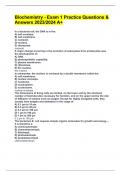
-
Biochemistry - Exam 1 Practice Questions & Answers 2023/2024 A+
- Exam (elaborations) • 10 pages • 2024
-
- $14.28
- + learn more
Biochemistry - Exam 1 Practice Questions & Answers 2023/2024 A+ In a bacterial cell, the DNA is in the: A) cell envelope. B) cell membrane. C) nucleoid. D) nucleus. E) ribosomes. nucleoid A major change occurring in the evolution of eukaryotes from prokaryotes was the development of: A) DNA. B) photosynthetic capability. C) plasma membranes. D) ribosomes. E) the nucleus the nucleus In eukaryotes, the nucleus is enclosed by a double membrane called the: A) cell membrane. B) nuc...
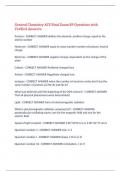
-
General Chemistry ACS Final Exam 89 Questions with Verified Answers,100% CORRECT
- Exam (elaborations) • 6 pages • 2024
-
- $11.39
- + learn more
General Chemistry ACS Final Exam 89 Questions with Verified Answers Protons - CORRECT ANSWER defines the element; positive charge; equal to the atomic number Neutrons - CORRECT ANSWER equal to mass number-number of protons; neutral charge Electrons - CORRECT ANSWER negative charge; dependent on the charge of the atom Cations - CORRECT ANSWER Positively charged ions Anions - CORRECT ANSWER Negatively charged ions Isotopes - CORRECT ANSWER when the number of neutrons varies but i...
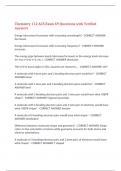
-
Chemistry 112 ACS Exam 69 Questions with Verified Answers,100% CORRECT
- Exam (elaborations) • 6 pages • 2024
-
- $10.99
- + learn more
Chemistry 112 ACS Exam 69 Questions with Verified Answers Energy (decreases/increases) with increasing wavelength? - CORRECT ANSWER decreases Energy (decreases/increases) with increasing frequency? - CORRECT ANSWER increases The energy gaps between levels (decrease/increase) as the energy levels increase (n=1 to n=2 to n=3, etc.) - CORRECT ANSWER decreases The O-Si-O bond angles in SiO₂ (quartz) are closest to... - CORRECT ANSWER 110° A molecule with 0 lone pairs and 2 bonding ...
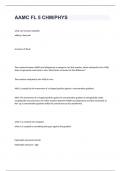
-
AAMC FL 5 CHM/PHYS fully solved graded A+
- Exam (elaborations) • 5 pages • 2024
- Available in package deal
-
- $11.49
- + learn more
AAMC FL 5 CHM/PHYSwhat can increase solubility adding a lone pair structure of flavin The reaction between NADH and ubiquinone is exergonic, but the reaction, when catalyzed by Na+-NQR, does not generate much heat in vivo. What factor accounts for this difference? The reaction catalyzed by Na+-NQR in vivo: ANS: is coupled to the movement of a charged particle against a concentration gradient. WHY: The movement of a charged particle against its concentration gradient is ener...

Do you wonder why so many students wear nice clothes, have money to spare and enjoy tons of free time? Well, they sell on Stuvia! Imagine your study notes being downloaded a dozen times for $15 each. Every. Single. Day. Discover all about earning on Stuvia


